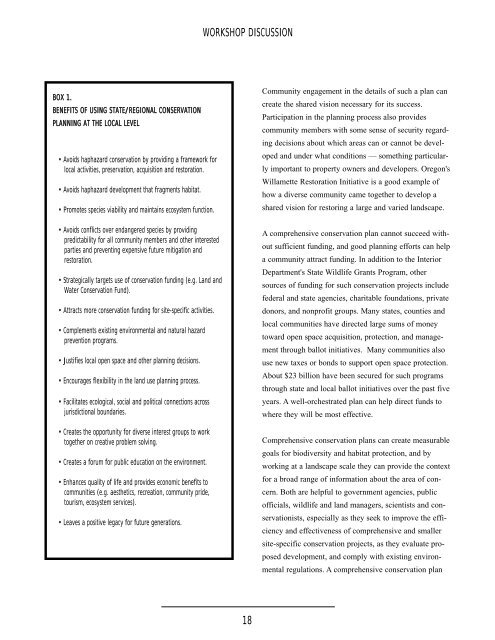Integrating Land Use Planning and Biodiversity - Defenders of Wildlife
Integrating Land Use Planning and Biodiversity - Defenders of Wildlife
Integrating Land Use Planning and Biodiversity - Defenders of Wildlife
Create successful ePaper yourself
Turn your PDF publications into a flip-book with our unique Google optimized e-Paper software.
WORKSHOP DISCUSSION<br />
BOX 1.<br />
BENEFITS OF USING STATE/REGIONAL CONSERVATION<br />
PLANNING AT THE LOCAL LEVEL<br />
• Avoids haphazard conservation by providing a framework for<br />
local activities, preservation, acquisition <strong>and</strong> restoration.<br />
• Avoids haphazard development that fragments habitat.<br />
• Promotes species viability <strong>and</strong> maintains ecosystem function.<br />
• Avoids conflicts over endangered species by providing<br />
predictability for all community members <strong>and</strong> other interested<br />
parties <strong>and</strong> preventing expensive future mitigation <strong>and</strong><br />
restoration.<br />
• Strategically targets use <strong>of</strong> conservation funding (e.g. <strong>L<strong>and</strong></strong> <strong>and</strong><br />
Water Conservation Fund).<br />
• Attracts more conservation funding for site-specific activities.<br />
• Complements existing environmental <strong>and</strong> natural hazard<br />
prevention programs.<br />
• Justifies local open space <strong>and</strong> other planning decisions.<br />
• Encourages flexibility in the l<strong>and</strong> use planning process.<br />
• Facilitates ecological, social <strong>and</strong> political connections across<br />
jurisdictional boundaries.<br />
• Creates the opportunity for diverse interest groups to work<br />
together on creative problem solving.<br />
• Creates a forum for public education on the environment.<br />
• Enhances quality <strong>of</strong> life <strong>and</strong> provides economic benefits to<br />
communities (e.g. aesthetics, recreation, community pride,<br />
tourism, ecosystem services).<br />
• Leaves a positive legacy for future generations.<br />
Community engagement in the details <strong>of</strong> such a plan can<br />
create the shared vision necessary for its success.<br />
Participation in the planning process also provides<br />
community members with some sense <strong>of</strong> security regarding<br />
decisions about which areas can or cannot be developed<br />
<strong>and</strong> under what conditions — something particularly<br />
important to property owners <strong>and</strong> developers. Oregon's<br />
Willamette Restoration Initiative is a good example <strong>of</strong><br />
how a diverse community came together to develop a<br />
shared vision for restoring a large <strong>and</strong> varied l<strong>and</strong>scape.<br />
A comprehensive conservation plan cannot succeed without<br />
sufficient funding, <strong>and</strong> good planning efforts can help<br />
a community attract funding. In addition to the Interior<br />
Department's State <strong>Wildlife</strong> Grants Program, other<br />
sources <strong>of</strong> funding for such conservation projects include<br />
federal <strong>and</strong> state agencies, charitable foundations, private<br />
donors, <strong>and</strong> nonpr<strong>of</strong>it groups. Many states, counties <strong>and</strong><br />
local communities have directed large sums <strong>of</strong> money<br />
toward open space acquisition, protection, <strong>and</strong> management<br />
through ballot initiatives. Many communities also<br />
use new taxes or bonds to support open space protection.<br />
About $23 billion have been secured for such programs<br />
through state <strong>and</strong> local ballot initiatives over the past five<br />
years. A well-orchestrated plan can help direct funds to<br />
where they will be most effective.<br />
Comprehensive conservation plans can create measurable<br />
goals for biodiversity <strong>and</strong> habitat protection, <strong>and</strong> by<br />
working at a l<strong>and</strong>scape scale they can provide the context<br />
for a broad range <strong>of</strong> information about the area <strong>of</strong> concern.<br />
Both are helpful to government agencies, public<br />
<strong>of</strong>ficials, wildlife <strong>and</strong> l<strong>and</strong> managers, scientists <strong>and</strong> conservationists,<br />
especially as they seek to improve the efficiency<br />
<strong>and</strong> effectiveness <strong>of</strong> comprehensive <strong>and</strong> smaller<br />
site-specific conservation projects, as they evaluate proposed<br />
development, <strong>and</strong> comply with existing environmental<br />
regulations. A comprehensive conservation plan<br />
18
















![[PDF] Community Development Toolkit - CommDev](https://img.yumpu.com/48616495/1/184x260/pdf-community-development-toolkit-commdev.jpg?quality=85)
